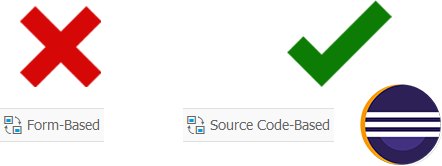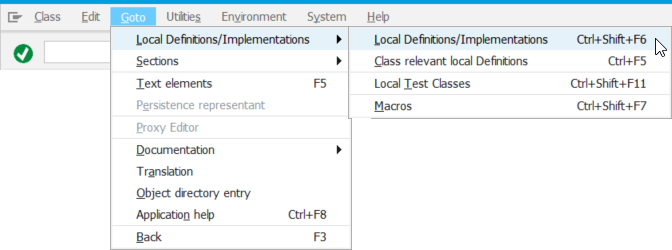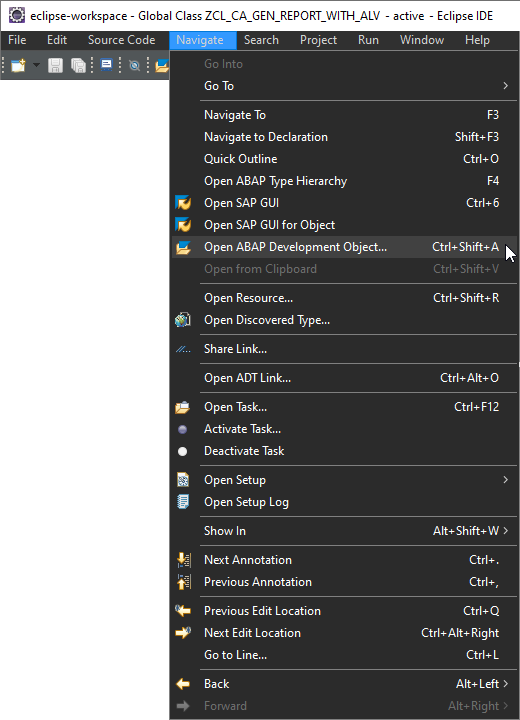
- SAP Community
- Groups
- Interest Groups
- Application Development
- Blog Posts
- Local ABAP exception classes (inside global classe...
- Subscribe to RSS Feed
- Mark as New
- Mark as Read
- Bookmark
- Subscribe
- Printer Friendly Page
- Report Inappropriate Content
- Why use local exception classes?
- Class editor: source-code based or ADT ⚠️
- Defining a local exception class
- Example
- Further reading
- Conclusion

Why use local exception classes?
Although it is generally best practice to create global exception classes, they can seem a bit overkill for some applications. Think of PoCs, demo scenarios, BAdI implementations, etc. A handy but not so well-known option for these situations is to define a local exception class inside the global class. These allow internal exceptions (exceptions raised within the class itself) to be handled without the need for another global DDIC object. The SAP Help Portal describes local classes as follows:
Local definitions, especially local classes, can be useful as auxiliary classes for the global class. In local classes you can encapsulate implementation details that should not be visible from the outside (they should not even occur in the private section).
Class editor: source-code based or ADT ⚠️
Before you get coding, take into consideration that local exception classes do not play well with the classical Form-Based Class Builder. Use the Source Code-Based editor or Eclipse with ADT instead.

Defining a local exception class
Source-code based Class Builder
To add a local exception class definition within a global class first open the global class in SE24 or SE80. Next, open the menu path Goto → Local Definitions/Implementations → Local Definitions/Implementations.

Alternatively, you can click the toolbar button labeled ‘Local Definitions/Implementations’. You can now enter the logic for the local exception class.

Eclipse with ADT
To add or edit a local class definition in the ABAP Development Tools in Eclipse, first open the global class. Do this via double-clicking the corresponding entry in the Project Explorer or via the ‘Open ABAP Development Object’ tool. Open the latter via its menu option Navigate → Open ABAP Development Object or its corresponding keyboard shortcut Ctrl + Shift + A.

After opening the global class, define the local exception class in the tab ‘Class-relevant Local Types’. Next, open its local types section by clicking the tab labeled ‘Local Types’. You can now enter the definition and logic.
As noted by matthew.billingham in the comment section, usually, it's fine to just have the local class definition in the ‘Local Types’ tab. However, this can cause problems in some cases. Prevent potential issues by declaring the class separately using ‘DEFINITION DEFERRED’ in the ‘Class-relevant Local Types’ tab.

Example
The example below showcases a basic exception class for handling exceptions in an ALV reporting class.
*"* use this source file for the definition and implementation of
*"* local helper classes, interface definitions and type
*"* declarations
CLASS lcx_ca_gen_report DEFINITION INHERITING FROM cx_dynamic_check.
PUBLIC SECTION.
INTERFACES if_t100_dyn_msg.
ALIASES msgty FOR if_t100_dyn_msg~msgty.
ENDCLASS.

We can now use this exception class in the internal methods of the global class.
"Program error in ALV-based output list, contact support
RAISE EXCEPTION TYPE lcx_ca_gen_report
MESSAGE e014(j_3rvatd).
Further reading
- Creating Local Definitions and Implementations, SAP Help Portal
- Classes & scope, Clean ABAP
- Error handling, Clean ABAP
- Local exception class in global class – the trick, SAP Community Blog
Conclusion
Local exception classes can provide distinct exceptions to internal class methods without creating a new global exception class. However, do they have added value in a particular situation? What is your opinion? Do you consider them a useful option for specific cases or a bad habit for lazy developers? Good practice or bad practice?
Share your feedback in the comments 👇
- SAP Managed Tags:
- ABAP Development,
- ABAP Testing and Analysis
You must be a registered user to add a comment. If you've already registered, sign in. Otherwise, register and sign in.
-
A Dynamic Memory Allocation Tool
1 -
ABAP
8 -
abap cds
1 -
ABAP CDS Views
14 -
ABAP class
1 -
ABAP Cloud
1 -
ABAP Development
4 -
ABAP in Eclipse
1 -
ABAP Keyword Documentation
2 -
ABAP OOABAP
2 -
ABAP Programming
1 -
abap technical
1 -
ABAP test cockpit
7 -
ABAP test cokpit
1 -
ADT
1 -
Advanced Event Mesh
1 -
AEM
1 -
AI
1 -
API and Integration
1 -
APIs
8 -
APIs ABAP
1 -
App Dev and Integration
1 -
Application Development
2 -
application job
1 -
archivelinks
1 -
Automation
4 -
BTP
1 -
CAP
1 -
CAPM
1 -
Career Development
3 -
CL_GUI_FRONTEND_SERVICES
1 -
CL_SALV_TABLE
1 -
Cloud Extensibility
8 -
Cloud Native
7 -
Cloud Platform Integration
1 -
CloudEvents
2 -
CMIS
1 -
Connection
1 -
container
1 -
Debugging
2 -
Developer extensibility
1 -
Developing at Scale
3 -
DMS
1 -
dynamic logpoints
1 -
Eclipse ADT ABAP Development Tools
1 -
EDA
1 -
Event Mesh
1 -
Expert
1 -
Field Symbols in ABAP
1 -
Fiori
1 -
Fiori App Extension
1 -
Forms & Templates
1 -
General
1 -
Getting Started
1 -
IBM watsonx
1 -
Integration & Connectivity
9 -
Introduction
1 -
JavaScripts used by Adobe Forms
1 -
joule
1 -
NodeJS
1 -
ODATA
3 -
OOABAP
3 -
Outbound queue
1 -
Product Updates
1 -
Programming Models
14 -
Restful webservices Using POST MAN
1 -
RFC
1 -
RFFOEDI1
1 -
SAP BAS
1 -
SAP BTP
1 -
SAP Build
1 -
SAP Build apps
1 -
SAP Build CodeJam
1 -
SAP CodeTalk
1 -
SAP Odata
1 -
SAP UI5
1 -
SAP UI5 Custom Library
1 -
SAPEnhancements
1 -
SapMachine
1 -
security
3 -
text editor
1 -
Tools
17 -
User Experience
5
| User | Count |
|---|---|
| 5 | |
| 3 | |
| 3 | |
| 3 | |
| 2 | |
| 2 | |
| 2 | |
| 2 | |
| 2 | |
| 1 |